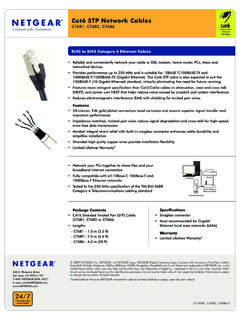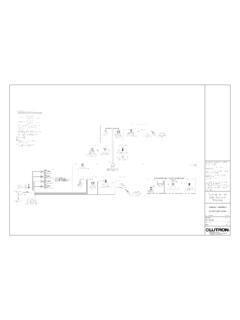Transcription of DMX Primer rev05 - CHAUVET Lighting
1 DMX Primer rev. 05 1 | Page DMX Primer Introduction The DMX protocol (USITT DMX512-A) is a networking protocol that enables a universal DMX controller device to control the features of multiple DMX compatible fixtures, whether PAR cans, wash lights, moving heads, followspots, foggers, or proprietary fixture controllers, etc. As any other networking protocol, the USITT DMX512-A describes the physical medium, the signals, and the functions they control. The Physical Medium DMX compatible fixtures are connected to the DMX controller using a DMX connection. This connection consists of a series of wired connections between the DMX controller and the various DMX compatible fixtures, also known as a daisy chain connection.
2 In this type of connection, the DATA OUT of one fixture or the DMX controller connects to the DATA IN of the next fixture, and so on. Each DMX fixture links to the previous and next DMX fixture or controller using a DMX cable. This type of cable consists of a section of shielded, two-conductor twisted pair cable with one 3-pin or 5-pin XLR male connector on one end, and a 3-pin or 5-pin XLR female connector on the other end. The XLR connectors pin-out is as follows: pin 1 is the Common (shield), pin 2 is Signal Negative (S-), and pin 3 is Signal Positive (S+). Note: For DMX, pins 4 and 5 are not used.
3 The Signals The DMX signal stream is unidirectional from the DMX controller to the DMX compatible fixtures. These signals conform to the EIA-485 standard. The stream of DMX signals consists of 512 individual, sequential channels that form a frame. The DMX controller constantly sends frames of DMX signals to the DMX connection, even if not all of the 512 channels are in use. Because of this constant transmission method, there can be only one DMX controller in a DMX connection. If not, the DMX signals sent by one controller would interfere with the signals sent by the other controller(s). DMX Universes A DMX universe is the set of DMX compatible fixtures connected to the same DMX daisy chain using the same set of 512 DMX channels.
4 Each set of 512 channels is referred to as a DMX Universe. In most cases, an installation will consist of only one DMX universe. However, you might find it necessary to define two or more universes because of constrains imposed by distance or the number of features. Most DMX controllers support only one universe, although some DMX controllers may support two or more universes. Each universe will have its own separated DMX daisy chain. A DMX compatible fixture can only be part of a single DMX universe. The Functions Each DMX channel can have any unitary value in the 000~255 range. Each DMX compatible fixture uses as many consecutive DMX channels as features the user can control.
5 The sequential numbers assigned to each DMX channel (1~512) are also known as DMX addresses. The function each DMX channel has, and the results of assigning a value to each depend on the personality (or DMX channel layout) of each controlled fixture. Some fixtures only use a single DMX channel, while others may require 15 or more DMX channels to control all their functions. Personalities are discussed in the next section, DMX Configuration. DMX Primer DMX Primer rev. 05 2 | Page DMX Configuration The DMX fixture configuration consists in determining how many channels each fixture will need as well as assigning the corresponding DMX channels to each fixture in order to size correctly the DMX controller.
6 Personalities A DMX personality describes what channel or channels control which fixture parameters. A DMX fixture may have many personalities to choose from. Each personality requires a different number of channels, based on the number of features the fixture enables. The number of DMX channels used by a fixture may vary from only one (usually the general dimmer control) to 15 or more. When a job does not require using all the fixture s capabilities, the user can select a more basic personality (less channels), allowing the DMX controller to accommodate more DMX fixtures. Starting Address For the DMX controller to control each DMX fixture, the user must first configure each fixture s personality to determine the number of channels required to control the fixture.
7 Each channel will have a DMX address assigned to it. However, since assigning a particular DMX address to each channel is impractical, the user will only need to configure the DMX address on each fixture that corresponds to the fixture s first channel of control. This is the fixture s starting address. The fixture will automatically assign the other channels to the subsequent DMX addresses. Once this assignment is complete, and based on the number of channels used, the fixture will respond to the DMX signals sent to the range of DMX channels that begins with the starting address. For example, a fixture that uses six DMX channels with a starting address of 100, will accept DMX data sent by the DMX controller to channels 100, 101, 102, 103, 104, and 105.
8 Assigning Addresses The user must carefully assign the starting addresses for each individual fixture to avoid DMX channel overlapping. If the DMX channels do overlap, the impacted fixtures could operate erratically. However, the user may decide to configure two or more similar fixtures with the same personality and starting address. In this case, all the fixtures with the same starting address will operate in unison. DMX Connectivity Connecting the DMX fixtures to a DMX controller in small to medium installations is usually a rather simple operation that requires a minimum of tools and some planning (not including the actual fixture rigging and configuration).
9 However, in large installations it may be necessary to plan carefully the position and cabling of each fixture to avoid unexpected problems. Fixture Location The order in which the fixtures connect to the DMX controller is not important and has no effect on how a controller communicates to each fixture. However, the user should always define a physical location for the fixtures that provides for the easiest and most direct cabling to the controller and other fixtures. DMX Primer DMX Primer rev. 05 3 | Page (DMX Connectivity cont.) Number of Fixtures When using a DMX controller, the combined number of channels required by all the fixtures on the DMX daisy chain determines the number of fixtures the DMX controller has to support.
10 Conversely, the number of onboard sliders, page buttons, and fixture buttons limits the number of discrete DMX channels a DMX controller can support. To comply with the EIA-485 standard, which is the base for the USITT DMX512-A protocol, do not connect more than 32 fixtures without using an optically-isolated DMX splitter. Doing otherwise may result in deterioration of the digital DMX signal. DMX Data Cabling You must use DMX compliant data cables to link two or more DMX compatible fixtures. You may purchase CHAUVET certified DMX cables directly from a dealer/distributor or construct your own cable. USITT recommends limiting the total length of the DMX cable (from the first fixture/controller to the last fixture) to 300~455 m (985~1,500 ft).








